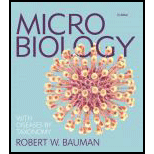
Microbiology with Diseases by Taxonomy (5th Edition)
5th Edition
ISBN: 9780134019192
Author: Robert W. Bauman Ph.D.
Publisher: PEARSON
expand_more
expand_more
format_list_bulleted
Concept explainers
Question
Chapter 6, Problem 9CT
Summary Introduction
To determine:
Describe nutritional classification of Desulforudis audaxviator.
Introduction:
Desulforudis audaxviator is a bacterium. It usually lives in depth from
Expert Solution & Answer
Want to see the full answer?
Check out a sample textbook solution
Students have asked these similar questions
What is the structure and function of Eukaryotic cells, including their organelles? How are Eukaryotic cells different than Prokaryotic cells, in terms of evolution which form of the cell might have came first? How do Eukaryotic cells become malignant (cancerous)?
What are the roles of DNA and proteins inside of the cell? What are the building blocks or molecular components of the DNA and proteins? How are proteins produced within the cell? What connection is there between DNA, proteins, and the cell cycle? What is the relationship between DNA, proteins, and Cancer?
Why cells go through various types of cell division and how eukaryotic cells control cell growth through the cell cycle control system?
Chapter 6 Solutions
Microbiology with Diseases by Taxonomy (5th Edition)
Ch. 6 - Prob. 1MCCh. 6 - In the laboratory, a sterile inoculating loop is...Ch. 6 - Superoxide dismutase _____________. a. causes...Ch. 6 - The most reactive of the four toxic forms of...Ch. 6 - Microaerophiles that grow best with a high...Ch. 6 - Prob. 6MCCh. 6 - Organisms that preferentially may thrive in icy...Ch. 6 - Prob. 8MCCh. 6 - Prob. 9MCCh. 6 - In a defined medium, ______________. a. the exact...
Ch. 6 - Prob. 11MCCh. 6 - Prob. 12MCCh. 6 - Prob. 13MCCh. 6 - Lyophilization can be described as ___________. a....Ch. 6 - Prob. 15MCCh. 6 - Prob. 1FIBCh. 6 - Prob. 2FIBCh. 6 - Prob. 3FIBCh. 6 - Prob. 4FIBCh. 6 - Prob. 5FIBCh. 6 - Prob. 6FIBCh. 6 - Prob. 7FIBCh. 6 - Prob. 8FIBCh. 6 - Prob. 9FIBCh. 6 - Prob. 10FIBCh. 6 - Prob. 11FIBCh. 6 - Prob. 1VICh. 6 - Prob. 2VICh. 6 - High temperature affects the shape of particular...Ch. 6 - Support or refute the following statement:...Ch. 6 - Prob. 3SACh. 6 - Why must media, vessels, and instruments be...Ch. 6 - Prob. 5SACh. 6 - Prob. 6SACh. 6 - Draw and label the four distinct phases of a...Ch. 6 - Prob. 8SACh. 6 - Prob. 9SACh. 6 - Prob. 10SACh. 6 - Explain the differences among photoautotrophs,...Ch. 6 - Prob. 12SACh. 6 - How does a chemostat maintain a constant...Ch. 6 - A scientist describes an organism as a...Ch. 6 - Pasteurization is a technique that uses...Ch. 6 - Prob. 3CTCh. 6 - Some organisms require riboflavin (vitamin B2) to...Ch. 6 - A scientist inoculates a bacterium into a complex...Ch. 6 - How can regions within biofilms differ in their...Ch. 6 - A scientific article describes a bacterium as an...Ch. 6 - Prob. 8CTCh. 6 - Prob. 9CTCh. 6 - Starting with 10 bacterial cells per milliliter in...Ch. 6 - Prob. 11CTCh. 6 - Prob. 12CTCh. 6 - The filamentous bacterium Beggiatoa gets its...Ch. 6 - Prob. 14CTCh. 6 - Examine the graph in Figure 6.3. Note that the...Ch. 6 - Prob. 16CTCh. 6 - Using the terms in Figure 6.8a, describe the...Ch. 6 - Prob. 18CTCh. 6 - Examine the ingredients of MacConkey agar as...Ch. 6 - Prob. 20CTCh. 6 - Using as many of the following terms as...Ch. 6 - Prob. 22CTCh. 6 - Viable plate counts are used to estimate...Ch. 6 - Using the following terms, fill in the following...Ch. 6 - Prob. 1TMWCh. 6 - Why do clinical laboratory scientists keep many...Ch. 6 - Prob. 3TMWCh. 6 - Culturing Microorganisms One of Kochs postulates...Ch. 6 - Clinical Case Study Boils in the Locker Room For...
Knowledge Booster
Learn more about
Need a deep-dive on the concept behind this application? Look no further. Learn more about this topic, biology and related others by exploring similar questions and additional content below.Similar questions
- In one paragraph show how atoms and they're structure are related to the structure of dna and proteins. Talk about what atoms are. what they're made of, why chemical bonding is important to DNA?arrow_forwardWhat are the structure and properties of atoms and chemical bonds (especially how they relate to DNA and proteins).arrow_forwardThe Sentinel Cell: Nature’s Answer to Cancer?arrow_forward
- Molecular Biology Question You are working to characterize a novel protein in mice. Analysis shows that high levels of the primary transcript that codes for this protein are found in tissue from the brain, muscle, liver, and pancreas. However, an antibody that recognizes the C-terminal portion of the protein indicates that the protein is present in brain, muscle, and liver, but not in the pancreas. What is the most likely explanation for this result?arrow_forwardMolecular Biology Explain/discuss how “slow stop” and “quick/fast stop” mutants wereused to identify different protein involved in DNA replication in E. coli.arrow_forwardMolecular Biology Question A gene that codes for a protein was removed from a eukaryotic cell and inserted into a prokaryotic cell. Although the gene was successfully transcribed and translated, it produced a different protein than it produced in the eukaryotic cell. What is the most likely explanation?arrow_forward
- Molecular Biology LIST three characteristics of origins of replicationarrow_forwardMolecular Biology Question Please help. Thank you For E coli DNA polymerase III, give the structure and function of the b-clamp sub-complex. Describe how the structure of this sub-complex is important for it’s function.arrow_forwardMolecular Biology LIST three characteristics of DNA Polymerasesarrow_forward
arrow_back_ios
SEE MORE QUESTIONS
arrow_forward_ios
Recommended textbooks for you
- Health Safety And Nutrition F/Young ChildHealth & NutritionISBN:9781305144767Author:MAROTZPublisher:CengageEssentials of Pharmacology for Health ProfessionsNursingISBN:9781305441620Author:WOODROWPublisher:Cengage

Health Safety And Nutrition F/Young Child
Health & Nutrition
ISBN:9781305144767
Author:MAROTZ
Publisher:Cengage

Essentials of Pharmacology for Health Professions
Nursing
ISBN:9781305441620
Author:WOODROW
Publisher:Cengage



